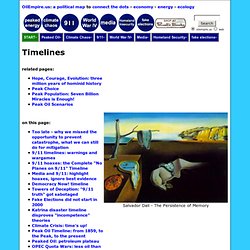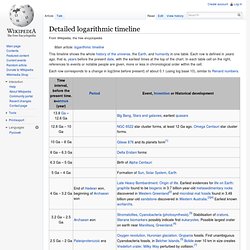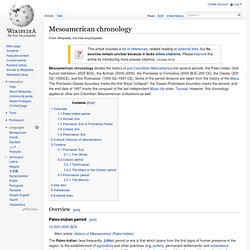

Timeline and Revenue/Valuation for top Social Media. Valuations of social media companies are starting to remind us of 1999.

But are they overvalued? Now that Microsoft bought Skype for $8.5 billion, LinkedIn's IPO valued the company at $8.9 billion after its first day of trading, and Facebook's estimated value is pushing $100 billion, you might be starting to wonder if buying into user numbers rather than revenue is a good idea. Social media site G+, a community of professionals, entrepreneurs and academics, put together this detailed infographic that lays it all out in front of you.
Take a look at these valuations and let us know in the comments if you think this is getting out of hand: (Click here for enlargement) Infographic courtesy Gplus.com. Timelines - timeline ecology ecologia economics economia history historia. Too late to prevent energy and environmental crises The military is very aware of the havoc that the end of cheap oil and the end of a relatively stable climate pose to civilization, and are ahead of the rest of society in planning for the disruptions.

Renewable energy does not necessarily mean that it will power a democratic, more egalitarian society. The concentration camp at Guantanamo Bay in Cuba, run by the United States, is partially wind powered, since there is lots of wind and the Cuban government is not obligated to sell electricity to the US compound still occupying a small part of Cuba. Perhaps the primary reason for the resource grab marketed as "The War on Terror" and the related "Homeland Security" surveillance system is an elite understanding that Peak Oil and Climate Change will reduce food and water supplies with tremendous consequences for billions of people dependent on industrial agriculture.
We are now faced with the fact that tomorrow is today. Democracy Now! Timeline Historia. Detailed logarithmic timeline. This timeline shows the whole history of the universe, the Earth, and humanity in one table.

Each row is defined in years ago, that is, years before the present date, with the earliest times at the top of the chart. In each table cell on the right, references to events or notable people are given, more or less in chronological order within the cell. Each row corresponds to a change in log(time before present) of about 0.1 (using log base 10), similar to Renard numbers. A logarithmic timeline can also be devised for events which should occur in the future, barring unforeseen circumstances and assuming that we can extrapolate into the future based on our science.
See also[edit] References[edit] External links[edit] Mesoamerican chronology. Mesoamerican chronology divides the history of pre-Columbian Mesoamerica into several periods: the Paleo-Indian (first human habitation–3500 BCE), the Archaic (3500–2000), the Preclassic or Formative (2000 BCE–200 CE), the Classic (200 CE–1000CE), and the Postclassic (1000 CE–1697 CE).

Some of the period divisions are taken from the history of the Maya: The Preclassic-Classic boundary marks the first Maya "collapse", the Classic-Postclassic boundary marks the second, and the end date of 1697 marks the conquest of the last independent Maya city-state, Tayasal. However, this chronology applies to other pre-Columbian Mesoamerican civilizations as well. Overview[edit] Paleo-Indian period[edit] The Paleo-Indian (less frequently, Lithic) period or era is that which spans from the first signs of human presence in the region, to the establishment of agriculture and other practices (e.g. pottery, permanent settlements) and subsistence techniques characteristic of proto-civilizations.